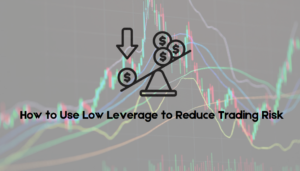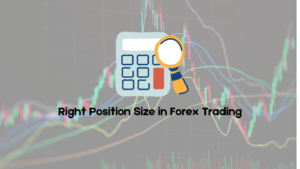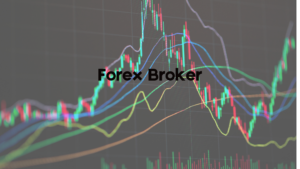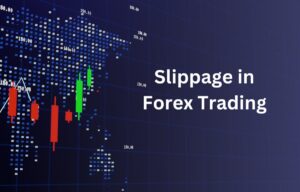A market order in Forex trading is a type of order used to buy or sell a currency pair immediately at the current market price. It is one of the most straightforward and commonly used order types because it guarantees execution, though not the price at which the trade will be executed. When a trader places a market order, it is filled as soon as it reaches the broker, and the transaction occurs at the best available price at that moment. This order type is ideal for those who want to enter or exit a trade without delay.
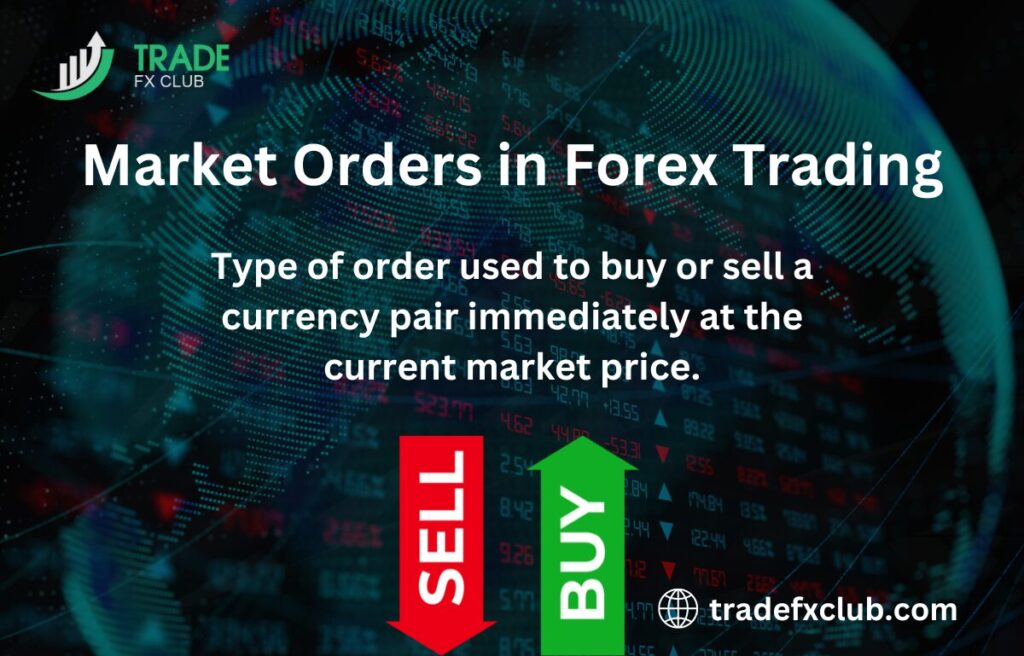
The execution of a market-order is instantaneous, making it highly suitable for fast-moving markets where prices can change rapidly. Traders use market orders when they prioritise getting into or out of a trade immediately rather than waiting for a specific price point. However, in very volatile markets, the price at which the order is executed might differ slightly from the price at which the order was placed, a phenomenon known as slippage.
How Does a Market Order Differ from Other Order Types in Forex?
Market orders differ from other order types in Forex primarily in their execution and price control. Unlike market orders, limit orders are placed at a specific price or better. A limit order only gets executed if the market reaches the specified price or better, meaning it does not guarantee execution but does guarantee the price. This is useful for traders who have a specific entry or exit point in mind and are willing to wait until the market hits that price.
Another key type is the stop order, which becomes a market-order once a certain price level (the stop price) is reached. A stop order is used to limit losses or lock in profits by triggering a market order when the stop price is breached. While market orders are executed immediately at the best available price, stop orders can result in execution at a different price due to market movement. Thus, market orders are generally preferred for their immediate execution, while limit and stop orders are used for their price control features.
When Should You Use a Market Order in Forex Trading?
Market-orders are best used when immediate execution is crucial, such as during times of high market activity or when rapid price movements are anticipated. For instance, if a trader identifies a significant news event that is likely to impact the market, using a market order allows them to enter or exit the position without waiting, capturing the price movement as it happens. This is particularly important in fast-moving markets where price changes can be swift and significant.
However, traders should be cautious of slippage, which can occur when there is high volatility or low liquidity. If the market is moving quickly, the price at which the order is executed might be different from the price when the order was placed. Therefore, market orders are ideal when you need to act quickly and are less concerned about the exact execution price, but it’s essential to be aware of the potential for slippage.
Advantages and Disadvantages of Market Orders in Forex
Advantages:Market-orders offer several significant advantages, primarily their immediacy and simplicity. One of the key benefits is the guarantee of execution; once you place a market order, it will be filled as soon as it reaches the broker, provided there is liquidity. This is advantageous for traders looking to enter or exit a position swiftly without waiting. Additionally, market orders are straightforward to use, making them suitable for both novice and experienced traders who need to act quickly on market information.
Disadvantages: Despite their advantages, market-orders come with some drawbacks. The primary disadvantage is the potential for slippage, especially in volatile markets or when trading in low liquidity conditions. Slippage occurs when the order is executed at a price different from the expected price, which can lead to less favourable trading outcomes. Furthermore, market orders do not offer control over the execution price, which can be problematic if the market price is moving rapidly or if a specific entry or exit price is crucial to the trading strategy.
How Market Orders Affect Forex Liquidity?
Market orders can have a direct impact on Forex liquidity, as they contribute to the trading volume and overall market activity. High volumes of market-orders increase liquidity by providing more opportunities for other traders to execute their trades. This, in turn, can lead to narrower bid-ask spreads, making it easier for traders to enter and exit positions at more favourable prices. Increased liquidity generally improves market efficiency and reduces the cost of trading.
However, in times of extreme volatility or during low liquidity periods, a surge in market orders can exacerbate price swings and lead to wider spreads. If the market cannot absorb the volume of market orders smoothly, it might lead to temporary liquidity shortages, causing significant slippage. This means that while market orders can enhance liquidity under normal conditions, they can also contribute to liquidity challenges when the market is under stress.
Risks Associated with Market Orders in Forex
One of the primary risks associated with market orders is slippage. In fast-moving or highly volatile markets, the price at which a market order is executed can differ significantly from the price at the moment the order was placed. This discrepancy can lead to higher costs or lower profits than anticipated, particularly if the market is experiencing rapid price changes.
Another risk is the potential for adverse price movement. Since market orders are executed immediately at the best available price, there is a risk that the market could move against the trader’s position right after execution. This risk is exacerbated in low liquidity environments where large market orders can impact the price more significantly. Traders need to be aware of these risks and may consider using other order types, such as limit or stop orders, to better control their entry and exit points.
How Do Forex Brokers Execute Market Orders?
Forex brokers execute market-orders by matching the order with the best available price in the market at the time the order is received. When a trader places a market order, it is sent to the broker’s trading platform, which then processes the order by either executing it directly or routing it to a liquidity provider. The liquidity provider is typically a financial institution or another broker that offers a pool of available prices. The broker’s role is to ensure that the order is filled as quickly and efficiently as possible.
The execution of market-orders can vary depending on the broker’s infrastructure and their relationships with liquidity providers. Some brokers use an Automated Trading System (ATS) to execute orders instantly, while others may use a dealing desk model where orders are executed against the broker’s own book. In a no-dealing desk (NDD) model, orders are sent directly to the interbank market or liquidity providers, which can result in faster execution and potentially better prices for the trader.
What Factors Influence the Execution Speed of Market Orders in Forex?
Several factors influence the execution speed of market-orders in Forex. One major factor is the broker’s technology and trading infrastructure. Brokers with advanced technology and robust systems can process orders more quickly and efficiently, reducing latency. Another critical factor is market liquidity. In highly liquid markets with tight bid-ask spreads, orders are executed faster because there is a larger pool of buyers and sellers ready to transact.
Market conditions also play a role in execution speed. During periods of high volatility or major economic news releases, the speed of execution can be affected as prices move rapidly and the availability of liquidity can change. Additionally, the broker’s execution model can impact speed; for example, brokers using an NDD model generally offer faster execution compared to those with a dealing desk model due to direct access to the interbank market.
How Do Slippage and Market Orders Relate in Forex Trading?
Slippage and market orders are closely related in Forex trading, as slippage is a common phenomenon associated with market orders. Slippage occurs when there is a discrepancy between the expected price and the actual execution price of a market order. This can happen in volatile market conditions where prices are moving rapidly, or during periods of low liquidity where there aren’t enough counter-parties to fill the order at the desired price.
Market orders are particularly susceptible to slippage because they are executed at the best available price at the moment the order is processed, which may differ from the price when the order was placed. This means that if the market price shifts quickly, the order might be filled at a less favourable price. Traders can mitigate the impact of slippage by using limit orders or by trading during periods of higher liquidity to reduce the likelihood of significant price changes.
What Are Common Strategies for Using Market Orders in Forex?
Market-orders are commonly used in various trading strategies where immediate execution is essential. One common strategy is the news trading strategy, where traders use market orders to capitalise on rapid price movements triggered by major economic announcements or geopolitical events. The immediacy of market orders allows traders to enter or exit positions quickly, taking advantage of the price swings that often follow significant news releases.
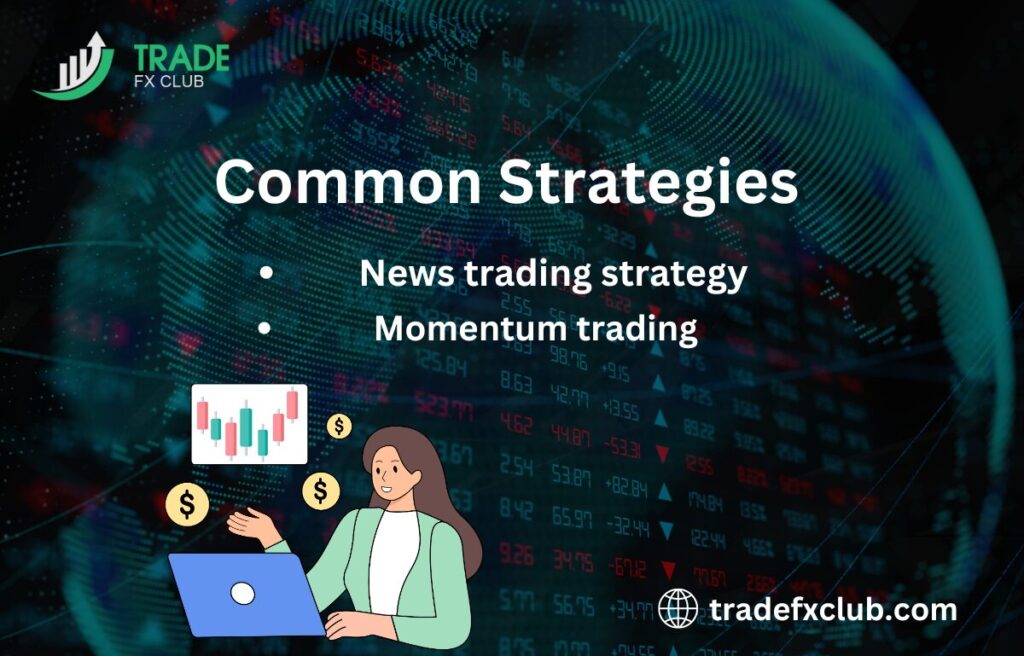
Another strategy involving market-orders is momentum trading. Traders use market orders to enter positions in the direction of a prevailing trend, hoping to capture short-term price movements. By placing a market order, traders aim to join the trend as it develops, benefiting from the immediate execution to lock in profits while the momentum is strong. This approach is effective in trending markets but requires quick decision-making and action to maximise potential gains.
How Do Market Orders Compare with Limit and Stop Orders in Forex?
Market orders, limit orders, and stop orders each serve different purposes and have distinct characteristics in Forex trading. Market-orders are executed immediately at the best available price, providing a guarantee of execution but not price control. In contrast, limit orders are used to buy or sell a currency pair at a specific price or better, meaning they only get executed if the market reaches the specified price. This allows traders to control the price at which their trades are executed but does not guarantee that the order will be filled.
Stop orders, on the other hand, are designed to become market-orders once a certain price level (the stop price) is breached. They are often used to manage risk by triggering an order to limit losses or lock in profits when the market reaches the stop price. While market orders ensure immediate execution, stop orders provide a mechanism for automatic trade execution based on price levels. Thus, while market orders offer speed and certainty of execution, limit and stop orders offer greater control over the price at which trades are executed.
How Does Market Volatility Impact the Effectiveness of Market Orders in Forex?
Market volatility can significantly impact the effectiveness of market orders, primarily through the phenomenon of slippage. During periods of high volatility, such as during major economic announcements or geopolitical events, market prices can fluctuate rapidly. This can lead to a difference between the expected execution price of a market order and the actual price at which the order is filled. As a result, traders might experience less favourable execution prices, which can affect their overall trading outcomes.
Volatility can also impact the speed of execution for market orders. In highly volatile markets, the availability of liquidity can vary, and the increased number of market orders can strain liquidity, leading to wider bid-ask spreads and slower execution times. Traders need to be aware of these conditions and may consider using limit orders or adjusting their trading strategies to account for potential slippage and slower execution during volatile market periods.
What Are the Best Practices for Placing Market Orders in High-Volume Forex Trading?
In high-volume Forex trading, the best practices for placing market-orders focus on optimising execution and managing potential slippage. One key practice is to monitor market conditions closely before placing a market order. Traders should assess liquidity and volatility to anticipate potential slippage and choose the optimal time to execute trades. Trading during periods of high liquidity, such as major market overlap times, can help minimise slippage and ensure better execution prices.
Another important practice is to use limit orders strategically when possible. While market-orders are used for immediate execution, limit orders can be employed to set specific entry or exit points at desired prices, especially in high-volume scenarios where rapid price changes are common. This approach helps manage execution prices more effectively. Additionally, traders should keep their order sizes in check to avoid market impact; placing excessively large market orders can exacerbate slippage and affect price stability.
How Do Different Forex Trading Platforms Handle Market Orders?
Forex trading platforms vary in how they handle market orders, largely depending on their execution models. Platforms with an Instant Execution model typically process market orders at the price displayed when the order is placed. However, if the market is moving quickly, the execution price may differ slightly from the displayed price due to slippage. These platforms may offer a simple and direct approach but can sometimes result in discrepancies during volatile periods.
Platforms with a Direct Market Access (DMA) or Electronic Communication Network (ECN) model route market orders directly to liquidity providers. This can provide faster execution and better price transparency, as orders are filled directly from the interbank market. In contrast, platforms with a Market Maker model may handle market orders internally, which can result in different execution conditions. Traders should understand their platform’s order handling mechanisms to manage expectations and optimise their trading strategies.
What Role Do Market Orders Play in Algorithmic Forex Trading?
In algorithmic Forex trading, market-orders play a crucial role in executing trades based on predefined algorithms and strategies. Algorithms often use market orders to capitalise on real-time data and execute trades immediately when specific conditions or signals are met. The speed and automation of market orders are essential for algorithmic trading, as they allow for precise and timely execution based on complex, data-driven strategies.
Market orders in algorithmic trading can help implement strategies such as high-frequency trading, where the goal is to exploit small price movements over a large number of trades. The immediacy of market orders supports this approach by ensuring that trades are executed without delay, maximising the effectiveness of the algorithm. However, algorithmic traders must also account for potential slippage and ensure their algorithms are optimised to handle high-volume trading conditions effectively.
How Do Market Orders Interact with Forex Market Depth?
Market orders interact with Forex market depth by consuming available liquidity at the best available prices. Market depth refers to the range of buy and sell orders at various price levels in the order book. When a trader places a market order, it is filled by executing against the available liquidity in the order book, starting from the best bid or ask price. If the order size is large relative to the liquidity at the top levels, it can impact the market depth by moving the price through several levels, potentially causing slippage.
In a deep and liquid market, where there are many buy and sell orders spread across various price levels, a market order is less likely to cause significant price changes and slippage. Conversely, in a market with shallow depth, where there are fewer orders at each price level, a large market order can move the market price considerably. Understanding market depth helps traders anticipate how their market orders might impact the price and adjust their strategies to manage potential risks associated with large or impactful trades.
What Are the Typical Market Order Execution Times in Forex?
The typical execution times for market-orders in Forex can vary depending on several factors, including the broker’s technology, market conditions, and liquidity. In general, market orders are designed to be executed almost instantly, often within milliseconds, especially on platforms with robust infrastructure and high-speed data feeds. During normal market conditions, execution is usually very fast, enabling traders to capture immediate price levels as intended.
However, execution times can be affected by factors such as high market volatility or low liquidity. During volatile periods or when trading in less liquid currency pairs, the time it takes to process and execute a market order might be slightly longer. Traders should be aware of these factors and choose brokers with reliable execution speeds and technology to minimise delays and ensure efficient trade execution.
How Can Traders Mitigate the Risks of Using Market Orders in Forex?
To mitigate the risks associated with market-orders in Forex, traders can employ several strategies. One effective approach is to use limit orders when possible, especially if precise entry or exit points are critical. By setting a limit order, traders can control the price at which their trades are executed, reducing the risk of unfavorable slippage. For high-frequency or immediate needs, however, market orders may still be necessary.
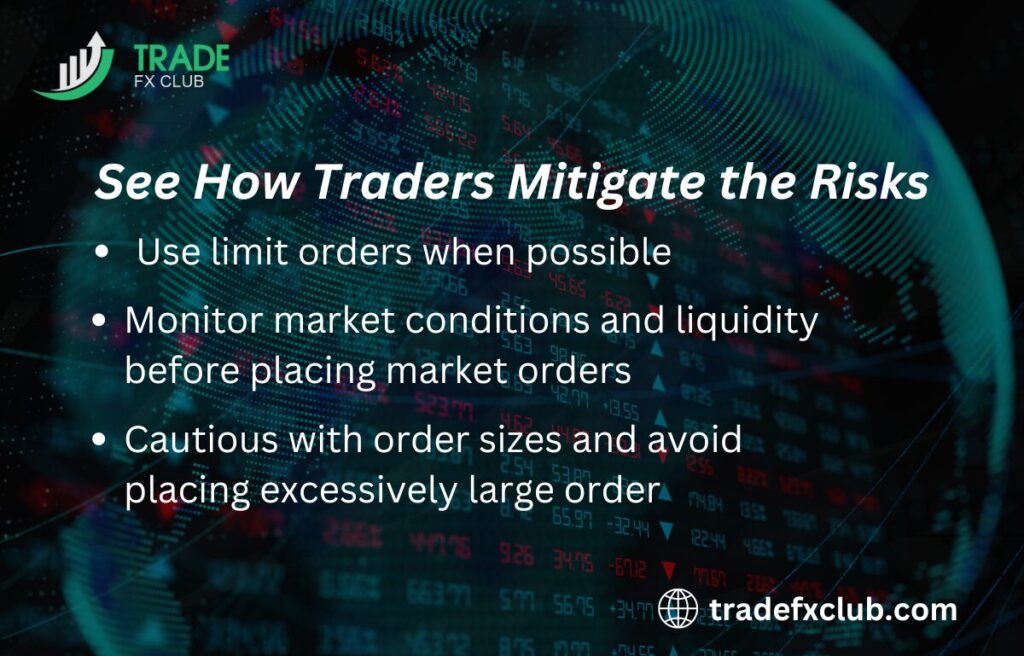
Additionally, traders should monitor market conditions and liquidity before placing market orders. Executing orders during periods of high liquidity and lower volatility can help minimize slippage and ensure more favorable execution prices. Using tools such as stop-loss orders can also help manage risks by automatically closing positions at predefined levels to limit potential losses. Lastly, traders should be cautious with order sizes and avoid placing excessively large orders that could significantly impact market prices.
How Do Market Orders Influence Forex Trading Psychology?
Market orders can significantly influence trading psychology by affecting traders’ perceptions of control and decision-making. The immediacy of market orders often gives traders a sense of quick resolution and certainty, which can lead to a heightened sense of confidence. This instant execution can reinforce the behaviour of reacting quickly to market movements, potentially leading to impulsive trading decisions. The rapid fulfilment of market orders might also lead to over-trading or frequent adjustments to positions, as traders seek to capitalise on short-term price movements.
On the other hand, the potential for slippage and less favourable execution prices with market orders can introduce stress and frustration. Traders might experience anxiety if they find that their orders are filled at significantly different prices than expected, which can impact their overall trading strategy and confidence. Understanding these psychological effects is important for maintaining a disciplined approach and managing the emotional aspects of trading, ensuring that decisions are based on sound strategy rather than reactionary impulses.
What Tools Can Be Used to Optimise Market Order Execution in Forex?
Several tools and technologies can help optimise market order execution in Forex. One key tool is the use of high-speed trading platforms and execution algorithms. Advanced trading platforms often provide features such as direct market access (DMA) and electronic communication networks (ECNs), which offer faster execution and better price transparency. These platforms can reduce latency and ensure that market orders are executed at or near the intended price, enhancing overall trading efficiency.
Another important tool is the use of trading indicators and real-time market data. Traders can leverage technical analysis tools and live data feeds to make more informed decisions about when to place market orders. By analysing market conditions and liquidity, traders can better time their orders to avoid periods of high volatility or low liquidity. Additionally, features like order routing options and slippage control settings can help optimise execution by directing orders to the most favourable execution venues and managing potential price discrepancies.
In Forex trading, there are many types of orders and market-orders play a critical role due to their immediacy and simplicity, allowing traders to enter or exit positions swiftly. However, their effectiveness can be influenced by various factors, including market depth, volatility, and liquidity. Understanding how market orders interact with these elements helps traders optimise their execution strategies and manage risks associated with slippage and price impact. Best practices such as monitoring market conditions and using appropriate tools can mitigate potential drawbacks and enhance the overall trading experience.
Moreover, trading psychology and technology both play significant roles in market-order execution. The rapid execution of market orders can boost confidence but also lead to impulsive decisions if not managed carefully. Tools like high-speed trading platforms, real-time data feeds, and order routing options can further refine execution, helping traders make more informed decisions and reduce execution-related issues. By leveraging these insights and tools, traders can effectively navigate the complexities of market orders and improve their trading outcomes.

